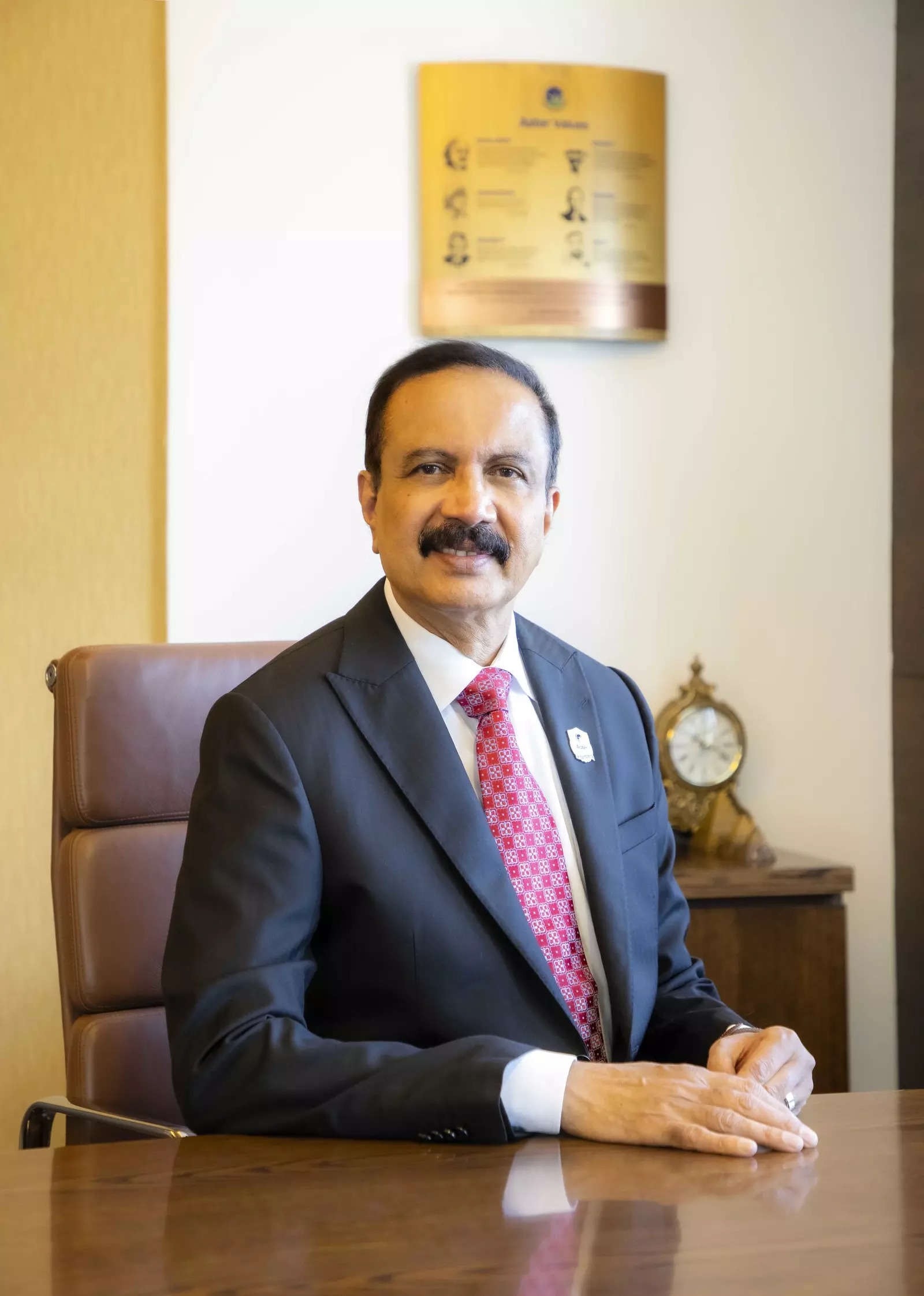
New Delhi: As the world marks World Health Day 2025, the theme of healthcare access and equity takes center stage. In an exclusive conversation with ETHealthworld, Dr. Azad Moopen, Founder and Chairman, Aster DM Healthcare discussed how digital transformation, innovative financing models, and collaborative efforts between the public and private sectors are shaping a healthier future. He emphasises that the focus should remain on strengthening primary healthcare, expanding insurance coverage, and leveraging technology for inclusive medical services.
What were the key inflection points in your journey from a single clinic to a global healthcare powerhouse, and how did the challenges and opportunities differ between India and international markets? What global learnings have shaped your approach to scaling healthcare?
Aster‘s journey from a single clinic in Dubai to a global healthcare powerhouse began in 1987, driven by the need to provide quality care, especially to underprivileged migrant workers. Overcoming early challenges, Aster expanded its network of clinics, pharmacies, and hospitals, evolving into a full-fledged healthcare ecosystem across nine countries.
Entering India in 2001 was a defining moment, bringing unique challenges like regulatory complexities and price sensitivity, but also immense growth potential. We operate 19 hospitals with 5,128 beds, 13 clinics, 203 pharmacies, and 254 labs across five states. The asset-light O&M model has enabled efficient expansion into tier 2 and tier 3 cities.
In 2023, Aster strategically separated its GCC and India businesses to unlock regional value. The recent merger with Quality Care India, backed by Blackstone, positions Aster among India’s top three hospital networks with over 10,150 beds in 27 cities, driving innovation and enhancing patient care. With a strong commitment to excellence, Aster continues to redefine healthcare standards globally.
How do brownfield and greenfield expansion help in optimising investment costs, and what advantages does brownfield expansion offer over greenfield in terms of capital expenditure?
Our expansion strategy combines brownfield and greenfield projects to optimize costs and accelerate growth. Brownfield acquisitions reduce upfront capital expenditure by 35-40 per cent and enable faster revenue generation, as seen in the ₹250 crore investment to expand Aster CMI Hospital, Bengaluru, from 500 to 850 beds. This approach has driven a 35 CAGR in India’s EBITDA over five years.
In addition to cost savings, brownfield expansions also offer a much faster route to revenue generation than the timeline needed for greenfield construction and regulatory approvals.
However, we also recognize the strategic importance of greenfield projects, particularly in underserved markets. These projects allow us to establish a strong presence in regions where suitable acquisition targets are scarce. Looking ahead, this dual strategy aims to scale Aster’s bed capacity in India to 6800+ by FY27. By combining the efficiency of brownfield expansions with the strategic reach of greenfield developments, we are confident in our ability to deliver sustainable growth and accessible, quality healthcare across India.
Is the O&M (Operations and Maintenance) model becoming a preferred strategy for hospital expansion in India? If so, what factors are driving this trend? Aster DM has adopted the O&M model for hospital expansion, particularly in regions where you already have a presence. What factors influence your choice of cities for this model, and how does this approach help in cost management and operational efficiency?
The Operations and Maintenance (O&M) model is emerging as a key hospital expansion strategy in India, enabling rapid growth without heavy capital investment. With hospital development costing ₹1-1.5 crore per bed, real estate investors seek healthcare operators for expertise, making O&M a viable solution. Post-pandemic, increased capital for infrastructure allows operators to focus on service delivery.
Our O&M strategy leverages brand strength and referral networks, prioritizing tier 1 and select tier 2 cities. This model delivers a 40% higher return on capital compared to owned facilities by reducing capital expenditure, sharing infrastructure costs, and optimizing staffing. Centralised procurement, standardized protocols, and shared services further enhance efficiency, ensuring quality care while driving sustainable growth.
Your hospitals in Tier 2 and 3 cities have significantly lower ARPOB compared to Tier 1 cities. How do you balance affordability with financial sustainability? Do you see Aster DM Healthcare playing a role in improving access to rural healthcare, given the rudimentary infrastructure in many parts of India?
We recognize the 30-40 per cent lower ARPOB in Tier 2/3 cities due to income levels, insurance penetration, and pricing dynamics. To balance affordability and sustainability, Aster centralizes complex procedures at larger hospitals while smaller units focus on primary/secondary care, optimizing efficiency through scale-driven procurement, standardized protocols, and shared administrative services.
By FY27, 57 per cent of planned bed additions will be in Tier 2/3 cities, reinforcing our commitment to these regions. Technology is key to bridging gaps, with telemedicine set to grow at 20.7 per cent CAGR, reaching $15.1 billion by 2030. Our digital health arm is expanding tele-ICU, teleradiology, AI-driven diagnostics, IoT monitoring, and EMR platforms to enhance accessibility, affordability, and quality care nationwide.
Can you elaborate on your approach to expanding virtual care in North India? How do you see digital technologies evolving in India?
India’s digital healthcare landscape is evolving rapidly, driven by 750M plus smartphone users, ABDM’s unified health ID, and telemedicine regulations. The COVID-19 pandemic further accelerated digital adoption.
Telemedicine cuts costs by 30 per cent, reduces readmissions by 40 per cent, and lowers consultation fees by 50 per cent. Our telecommand centre in Bengaluru enhances remote care across India, improving access in underserved areas.
AI and IoT are revolutionizing healthcare, enabling remote monitoring for chronic conditions. Aster’s upcoming “Aster Health” app will streamline appointments, test results, medication reminders, and virtual consultations.
Looking ahead, AI-driven decision support and integrated digital health platforms will shape the future. With strategic tech investments, Aster DM Healthcare is poised to lead India’s virtual care revolution.
Why has Aster DM Healthcare not been keen on joining PMJAY, when many private hospitals have also shown reluctance or opted out of the scheme? What changes in government policies would make private hospitals more willing to participate? What kind of regulatory framework would best support private sector involvement while ensuring affordability?
PMJAY is a transformative initiative expanding healthcare access for underserved populations. Under PM Modi’s leadership, it has provided free health insurance to millions, strengthening healthcare infrastructure and digital health adoption.
We support PMJAY’s long-term success through collaboration and technology. Our telehealth platform can extend specialist consultations to remote areas, reducing travel and hospitalization costs. Digital health records can streamline processes, improving efficiency and claims management.
To boost private sector participation, we aim to co-develop innovative financing models with the government, ensuring sustainability. Committed to PMJAY’s success, we look forward to working with stakeholders to deliver accessible, affordable, and high-quality healthcare for all.
There is a perception that private healthcare is exploitative and lacks regulation. What steps should the government take to improve trust while ensuring fair pricing?
The perception that private healthcare is exploitative often arises from occasional untoward incidents that overshadow the sector’s overall contributions to improving healthcare access. We firmly believe that trust is the cornerstone of effective healthcare delivery, and we are committed to fostering trust through transparency, accountability, and patient-centric care.
To strengthen trust in private healthcare, we see an opportunity for collaborative efforts between the government and the private sector. Transparent pricing guidelines could allow patients to understand the factors influencing healthcare costs while enabling providers to maintain quality standards. A collaborative framework that integrates transparency with outcome-based standards could ensure fairness while encouraging innovation.
You advocate for mandatory accreditation for hospitals and medical professionals. What global models do you think India should adopt to improve healthcare quality standards?
Mandatory accreditation is a game-changer for healthcare quality, ensuring standardized protocols, patient safety, and accountability. I advocate for its implementation not just in India but across SAARC nations to drive continuous improvement, enable cross-border collaboration, and enhance healthcare access.
India has made significant progress through accreditation bodies like NABH (National Accreditation Board for Hospitals & Healthcare Providers), NABL (National Accreditation Board for Testing and Calibration Laboratories), and international standards such as JCI (Joint Commission International). Given the country’s diverse healthcare landscape, accreditation must balance global best practices with local challenges like resource constraints. Beyond compliance, it should foster a culture of excellence, strengthening trust between providers and patients.
As India advances toward universal health coverage, integrating outcome measures and patient experience into accreditation will be crucial. Specialty-specific standards in fields like oncology and cardiology can further refine quality care.
Do you think different hospitals should have different pricing structures based on their infrastructure and services? How can this be implemented in a way that benefits both patients and healthcare providers?
Transparency could be one of the keys to success in the Indian healthcare system. Patients should have access to clear information for what they are paying —whether it’s advanced clinical capabilities or enhanced hospitality services. Mechanisms such as outcome-based quality indicators or patient satisfaction metrics could further enable patients to evaluate value beyond just price.
Global accreditation systems offer valuable lessons. By introducing tiered classifications with defined criteria for each level of service, there are lessons from the global system that has successfully created an equitable system balancing quality with affordability. India could adapt similar models to its unique context while leveraging technology to enhance transparency and efficiency. By adopting a balanced approach that aligns pricing with infrastructure and service levels while ensuring accessibility for all segments of society, we can build a healthcare ecosystem that prioritizes both patient welfare and provider sustainability.
What are your expectations for Aster DM’s financial trajectory in the coming quarters? How do you plan to balance expansion with profitability? As a leader in the private healthcare sector, how do you see the industry evolving over the next 5–10 years? What major trends will shape the future of healthcare in India?
Aster DM Healthcare is set for sustained financial growth, targeting 12-15 per cent annual revenue expansion through rising patient volumes, specialty services, and digital health scaling. India operations have shown strong momentum, with revenue up 15% YoY to ₹3,138 crores in the first nine months of FY25, and EBITDA margins improving to 19.5 per cent from 16.6 per cent. As facilities mature and insurance penetration rises, margins are expected to strengthen further.
Our strategy balances expansion with profitability through disciplined capital allocation. Investments focus on existing markets to maximize infrastructure and brand leverage. The O&M model has boosted bed capacity while improving ROCE by 470 basis points to 19.4 per cent. Digital health initiatives, like our inhouse app, extend our reach with minimal capital requirements, enhancing both accessibility and efficiency.
Looking ahead, India’s healthcare sector will see rapid consolidation as larger players outpace standalone facilities, driven by regulatory shifts, tech investments, and payor preferences for integrated networks. Hospitals will increasingly handle complex interventions, while routine care transitions to ambulatory and home-based models, aligning with global trends in cost efficiency and patient convenience.
You have taken on multiple roles throughout your career and accomplished remarkable milestones. Do you feel a sense of fulfillment, or are there new aspirations that continue to drive you forward?
After four decades in healthcare, building a network of 960+ facilities and impacting millions of lives, I feel profound gratitude rather than completeness. What began as a modest ambition has grown into one of the largest integrated healthcare providers in the Middle East and India.
With the next generation, my eldest daughter—Alisha Moopen leading in the GCC, and my youngest daughter Zeba Moopen, laong with my son-in-law Anoop Moopen driving growth in India—our vision continues to thrive. While they manage daily operations, my aspirations now focus on three key areas: expanding technology-driven healthcare access, mentoring future healthcare leaders, and developing sustainable models for underserved communities.
True success lies in creating lasting systems that continue to serve beyond our direct involvement. Healthcare remains both a calling and a responsibility, driving my commitment to innovation, accessibility, and impact.

